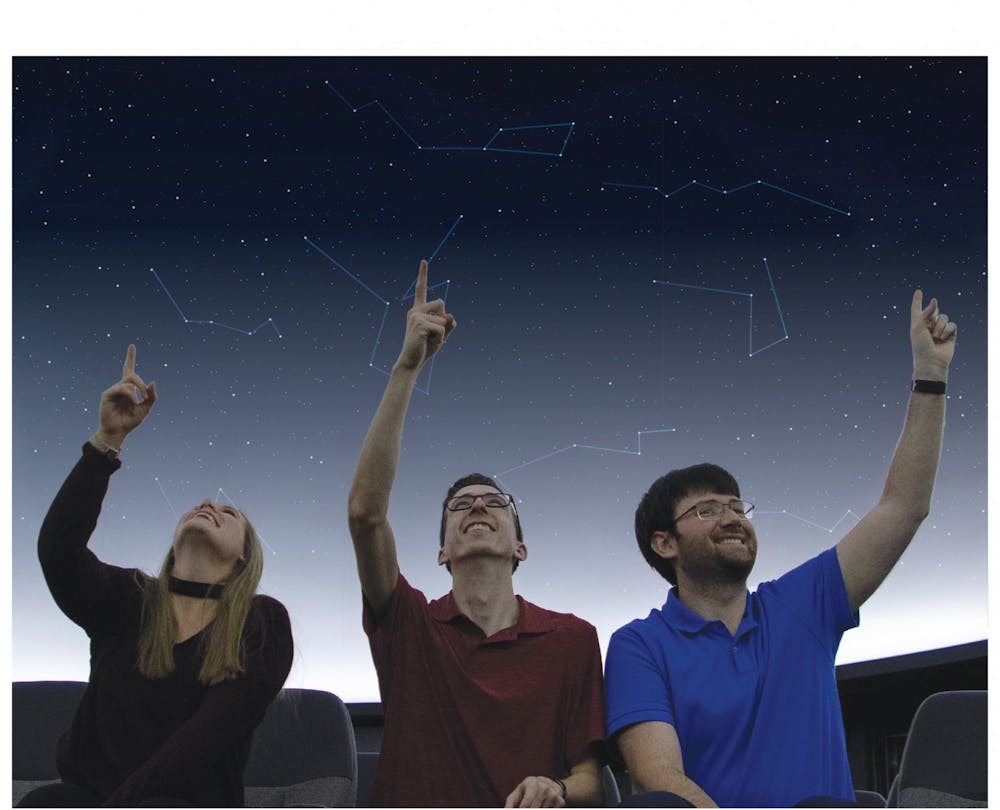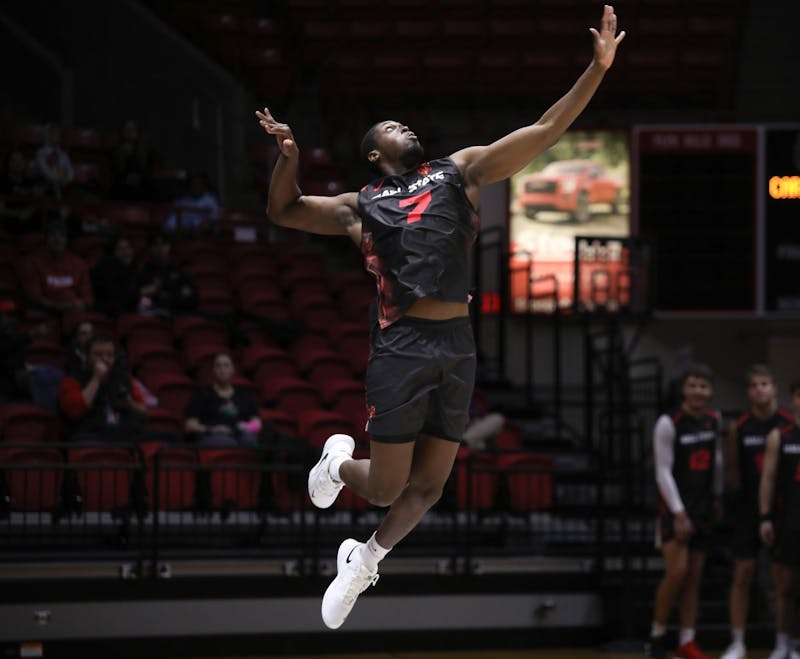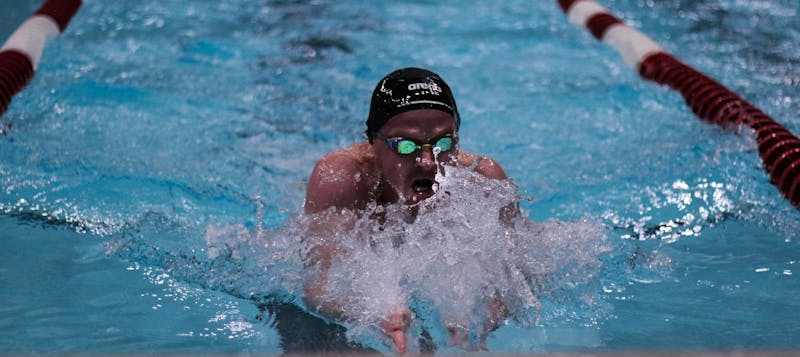Editor's Note: A previous version of this article misspelled Daniel Brossard's name. It has since been updated and corrected.
Under the 52-foot dome in the Charles W. Brown Planetarium, more than 20,000 visitors a year learn about what exists beyond the Earth’s atmosphere in space. But before visitors sit back and look up at the simulated sky, they are first greeted by Ball State students who work behind the scenes.
Meet three individuals from the planetarium’s student staff who have said their love for astronomy and physics is everlasting.
Brielle Tilson
At the end of every show she leads at the planetarium, Brielle Tilson, graduate student in the Department of Physics and Astronomy, said she leaves time for individuals to ask questions. One of her favorite questions to answer is, “Are there planets outside of our solar system?”
“A lot of people just grow up learning about the planets in our solar system, and somehow along the way, nobody had yet told them that we have found thousands of planets outside our solar system circling other stars,” Tilson said. “This always blows people’s minds, and it is so rewarding to see their brains start to get a better picture for how vast the size of our universe is.”
One of Tilson’s experiences that showed her how much exists in our universe happened when she visited Taylor University’s observatory. There, she had the opportunity to view the Moon, Mercury, Venus, Mars, Jupiter and Saturn through the university’s reflecting telescope.
“I was able to see Saturn’s rings, Jupiter’s Great Red Spot and the Moon’s craters in detail. I was even able to see the Galilean Moons around Jupiter,” Tilson said. “That was the first time that it all became very real to me. I was studying chemistry at the time but immediately decided to add a physics minor because I wanted to know more.”
Because Tilson is a graduate assistant, part of her assistantship is to grade papers and teach labs, but she was also assigned as a planetarium assistant.
“I was very grateful to immediately start working in the planetarium since I was picked out of all the other graduate students to get the job,” Tilson said.
On average, Tilson said, she spends 10 hours a week in the planetarium. During this time, she presents live shows and education programs to students and adults. The planetarium usually shows pre-recorded programs, ranging from pre-K-appropriate material to content for older audiences about exoplanets.
On weekends, Tilson said, she assists with the planetarium’s public shows by leading activity stations and facilitating crowds.
“The activity station consists of a trained facilitator, like myself, who has a hands-on activity that encourages guests to explore a physics or astronomy concept,” Tilson said. “The activity stations are geared to suit all ages.”
Through speaking with audiences, Tilson said she has become a better public speaker. Learning to communicate science is vital as a scientist, she said, because it is important to be able to communicate the ideas of one’s research and discoveries to an audience.
“I have always been an entertainer and have loved being a representative of something that I am passionate about,” Tilson said. “I love being in front of an audience, capturing them into a moment that we both get to share together.”
Tilson said she is currently applying to PhD schools in fields such as astrochemistry and computational chemistry, and her ultimate dream is to work at NASA.
“As a chemist and a physicist that loves astronomy, astrochemistry is where it all comes together,” Tilson said. “It is an interdisciplinary field where I can study the physics and chemistry happening in space.”
Kyle Koeller
While working at the planetarium, Kyle Koeller, junior astronomy major, said his favorite aspect is being able to talk to a variety of people who walk through the planetarium's door.
“There are a lot of interesting characters that you get to [meet] because it's a free public show, so literally anyone can come in off the street,” Koeller said. “So, you get a lot of interesting people that come in who are obviously at the spectrum of people who [either] don't want to talk and just go to the show, [or] you have people who only talk to you for 20 minutes, and then everyone else in between.”
Koeller said one of his high school teachers sparked his interest in physics and astronomy, and he fell in love with it as soon as he started the class. After taking more classes in the physics and astronomy realm, Koeller said, he decided astronomy was what he wanted to pursue in college.
“I [thought], ‘Well, [Ball State] has a planetarium — maybe I should just apply,’” Koeller said. “It was the spring semester of my sophomore year when I just asked if I could come in and work at the planetarium. Not many universities have a planetarium that you can have your students work at for real-life application experience. It's really hard to get practical experience as an undergraduate just because you can't go out and grab a piece of a star and bring it back.”
During shows, Koeller said, he greets visitors and counts the number of people who come to each showing. Because the events are offered to the public, Koeller said, he believes the planetarium helps brings the community together.
“Everyone stares at [the sky], but not all people know a lot [about it],” Koeller said. “So, when [visitors] go outside, and it's clear, [they say], ‘Oh, that's what I saw 20 minutes ago.’”
Daniel Brossard
When he was in the third grade, Daniel Brossard, second-year physics master’s student, would collect all the planet stickers his teacher would give out. His collection is what started his passion for the planets, he said.
“That interest eventually blossomed into me spending time in middle school learning what I could on the internet about the planets in our solar system and then eventually about exoplanets after I found out we had found planets around other stars,” Brossard said. “Although I’ve learned a lot about all different areas of astronomy, I still have a particular passion for learning about the multitude of planets we’ve discovered.”
Brossard said he is most passionate about planetary astronomy, particularly exoplanets, and he is fascinated by the endless possibilities each planet holds.
“I like to think about what the planet would look like from space,” Brossard said. “I also like to think about how a planet formed, what its history is, how did it get to be where it is today. If the planet is farther from its star, it’s fun to think about if life has evolved there and what that might look like.”
Brossard’s first experience with a planetarium happened during his first weekend in Muncie. When he visited the Charles W. Brown Planetarium for the first time, he said, he was taken aback by how big the planetarium is and how realistic the stars looked.
“It reminded me of really clear nights, looking at the sky out in the country without any light pollution,” Brossard said.
Because graduate students are assigned duties within the Department of Physics and Astronomy, Brossard said he was lucky enough to be assigned to the planetarium and began working the spring semester of his first year as a master’s student at Ball State.
Brossard said he spends most of his time at the planetarium presenting shows to school groups throughout the week while also greeting visitors and running educational activities on the weekends.
During each show he presents, Brossard said, he attempts to generate more interest in astronomy by making them as fun and engaging for audiences as possible. He said he enjoys presenting to students because he has the opportunity to share his passion with individuals who might not know about space as much as he does.
“I hope to inspire future generations to want to learn even more about astronomy and maybe even someday decide to become astronomers themselves,” Brossard said. “I always enjoy getting to talk about astronomy with others. I hope that something I say might be able to spark the same sort of interest in it that I have.”
Contact Kamryn Tomlinson with comments at kptomlinson@bsu.edu or on Twitter @peachykam.





The Daily News welcomes thoughtful discussion on all of our stories, but please keep comments civil and on-topic. Read our full guidelines here.